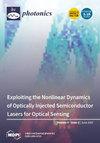Multiwavelength Fluorescence and Diffuse Reflectance Spectroscopy for an In Situ Analysis of Kidney Stones
IF 2.1
4区 物理与天体物理
Q2 OPTICS
引用次数: 0
Abstract
This study explores the use of diffuse reflectance spectroscopy (DRS) and multiwavelength fluorescence spectroscopy for real-time kidney stone identification during laser lithotripsy. Traditional methods are not suitable for in situ analysis, so the research focuses on optical techniques that can be integrated with lithotripsy fibers. Experiments were conducted ex vivo, using DRS and multiwavelength fluorescence spectroscopy (emission–excitation matrix (EEM)) to distinguish between 48 urinary stones of three types: urate, oxalate and hydroxyapatite, with infrared spectroscopy as a reference. A classification model was developed based on EEM and DRS data. Initial classification relying solely on EEM data achieved an f1-score of 87%, which increased to 92% when DRS data were included. The findings suggest that optical spectroscopy can effectively determine stone composition during laser lithotripsy, potentially enhancing surgical outcomes via the real-time automatic optimization of laser radiation parameters.用于肾结石现场分析的多波长荧光和漫反射光谱技术
本研究探讨了漫反射光谱(DRS)和多波长荧光光谱在激光碎石过程中实时肾结石鉴定中的应用。传统的方法不适合原位分析,因此研究的重点是与碎石纤维相结合的光学技术。在离体实验中,采用DRS和多波长荧光光谱(发射激发矩阵(EEM))技术,以红外光谱为参照,对48种不同类型的尿路结石进行了区分:尿酸盐、草酸盐和羟基磷灰石。基于EEM和DRS数据建立了分类模型。仅依靠EEM数据的初始分类获得了87%的f1分,当纳入DRS数据时增加到92%。研究结果表明,光谱学可以有效地确定激光碎石过程中的结石成分,通过实时自动优化激光辐射参数,有可能提高手术效果。
本文章由计算机程序翻译,如有差异,请以英文原文为准。
求助全文
约1分钟内获得全文
求助全文
来源期刊

Photonics
Physics and Astronomy-Instrumentation
CiteScore
2.60
自引率
20.80%
发文量
817
审稿时长
8 weeks
期刊介绍:
Photonics (ISSN 2304-6732) aims at a fast turn around time for peer-reviewing manuscripts and producing accepted articles. The online-only and open access nature of the journal will allow for a speedy and wide circulation of your research as well as review articles. We aim at establishing Photonics as a leading venue for publishing high impact fundamental research but also applications of optics and photonics. The journal particularly welcomes both theoretical (simulation) and experimental research. Our aim is to encourage scientists to publish their experimental and theoretical results in as much detail as possible. There is no restriction on the length of the papers. The full experimental details must be provided so that the results can be reproduced. Electronic files and software regarding the full details of the calculation and experimental procedure, if unable to be published in a normal way, can be deposited as supplementary material.
 求助内容:
求助内容: 应助结果提醒方式:
应助结果提醒方式:


